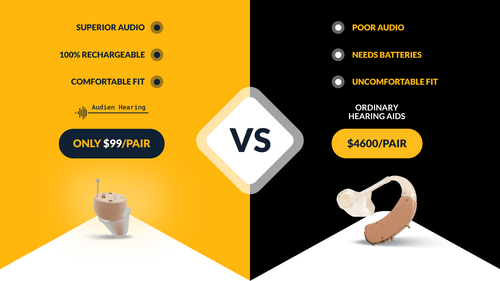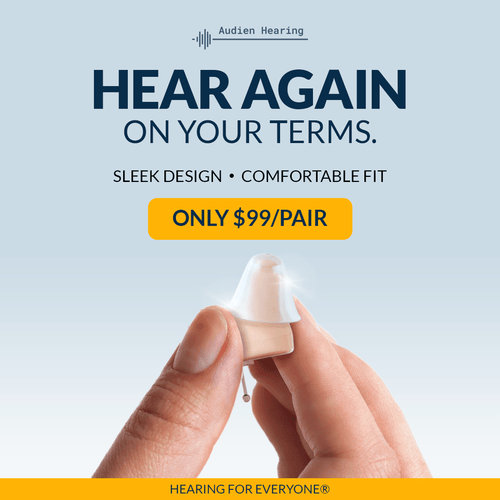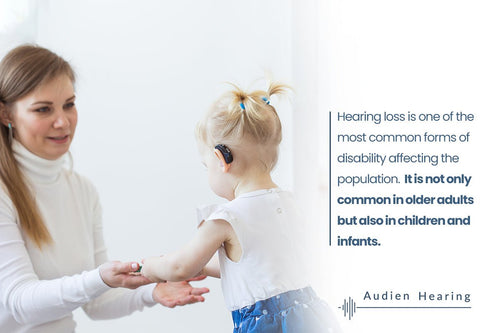
Hearing loss is an extensive, dynamic term that refers to depreciation in someone's ability to naturally hear the sound without assistance. Not everyone who has hearing loss requires treatment or assistive technology like hearing aids.
For those that do, they find that these devices become a part of their daily life. Because these devices have become such a big part of their everyday life, the concepts of waterproof and water-resistant hearing aids are very important. Daily life means rain storms, washing the car, going for a swim, and general exposure to moisture. So what is the difference between waterproof and water-resistance, and how can this technology impact your experience with hearing aids?
Currently, Audien Hearing does not carry hearing aids with waterproof or water-resistant abilities; however, we are always working to bring you the highest quality over-the-counter hearing aids on the market and advance their technology!
What Is a Hearing Aid?

Before we get into the nuts and bolts of waterproof and water-resistant technology and how to understand it better, let's take a closer look at hearing aid devices.
Hearing aids are designed to assist people who have different levels of hearing loss. These devices represent some of the most advanced medical technology on the market and are constantly evolving and changing.
What Is a Decibel?
When a person suffers from hearing loss, their natural ability to hear sound waves begins to decline. This decline in hearing is represented by what we call a decibel threshold. Everyone who has normal or non-impaired hearing can hear a multitude of different sound wave frequencies at natural decibel thresholds.
The term decibel is a measurement of the natural force or power that a sound wave has. Every sound wave frequency that we hear has a natural decibel level or threshold that it naturally presents as.
For instance, someone with mid-range, or cookie bite, hearing loss has trouble recognizing frequencies from 500-2000 Hz. It’s not so much that that person’s mind cannot understand these frequencies, but more the fact that these frequencies fall beneath that person’s acquired decibel threshold.
The threshold for these frequencies is well below normal hearing, so the frequencies are easily recognized. As a person experiences a decline in hearing, they will experience an increase in their decibel threshold - so now, these frequencies do not have the adequate threshold to be recognized.
How Does a Hearing Aid Work?
What a hearing aid does is take these specific frequencies that a person may have trouble hearing. It boosts the natural decibel level of that frequency - essentially making them louder and more powerful. By raising the decibel level of the frequency, now the individual with impaired hearing can recognize the frequency and translate it into sound.
As you might imagine, this process takes a level of advanced technology to achieve. Hearing aids are equipped with speakers, processors, and battery sources that make all of this possible.
On top of that, to have a prescription hearing aid, a person must go through an expensive battery of tests with an audiologist to assess their specific hearing loss needs. Although, most tests are covered by insurance. This specific diagnosis can then be used to program hearing aids to help a person with the specific frequencies they struggle to recognize.
Hearing Aids Are an Important Investment
For a person to get prescription hearing aids, this can mean thousands of dollars and expensive doctors appointments.
For many people, this high cost can be an obstacle. The Audien Hearing team has worked hard to present another option that doesn’t have to break your bank. We have developed high-quality, over-the-counter, one-size-fits-all hearing aids that we can get into your hands for less than one hundred dollars.
In addition, we utilize the highest possible technology that helps to mute background sound and help you focus on what you want to be hearing. We also have a satisfaction guarantee and are highly rated by satisfied customers.
Whether you are taking the path of prescription hearing aids or trying out an over-the-counter option, you’ll be making a small investment in improving your hearing. Not only do they represent a financial investment, but they represent a way for you to get back to living your life the way you did before your hearing loss.
Benefits of Waterproof and Water-resistant Technology

Because of the prevalence of this technology in your life, the ability to have either waterproof or water-resistant qualities is obvious. Not only do you not want to be handicapped from enjoying certain activities that require water - like washing the car with the kids or bathing the dog, but there is also the concern of getting caught in natural elements like the rain.
At the moment, the market largely doesn’t have many options when it comes to waterproof or water-resistant hearing aids. However, this is an area that the industry is moving in as the popularity of these qualities continues to grow. For instance, most cell phones made in their base models have at least water-resistant status, as this technology is being developed and becoming more and more accessible to manufacturers.
But what exactly is waterproof, and what is water-resistant technology? How does it work, and how can you better understand and recognize this technology when you see it?
Waterproof and Water-resistant Technology - What You Need To Know
When we talk about terms like waterproof and water-resistant, we automatically think about certain activities like jumping in the pool with your smartwatch or not being afraid of your toddler spilling water on your work tablet. But what exactly do these terms mean, and how can we know how to intelligently gauge how much water a piece of technology can safely survive?
Not All Devices Are Equal
Not all devices are going to be made equal when it comes to the amount of liquid they can experience without malfunctioning. There are three general categories that most technology falls under when it comes to their interactions with liquids: water-resistant, water-repellent, and waterproof. These three categories are based on a universal rating established as an industry standard across all manufacturers. That standard is called an IP rating.
Understanding How To Read an IP Rating
An IP rating stands for ingress protection rating and is a universal standard of how much exposure a piece of technology can withstand to certain natural elements. The IP instead itself is composed of two numbers displayed side by side.
The first number represents the level of resistance that a device has towards dust and small particles. This number is indicative of how tightly built a device is to resist damage that might come from dirt, dust or any kind of particle that could damage your device.
This IP rating is done from zero to six, with six being completely dust tight. People who enjoy the outdoors or take a trek into naturally dusty environments like a construction worker will want to find a device with a high IP rating for dust.
The second number is related to a device's ability to be liquid resistant. This rating is measured from zero to nine and follows the same trend. The higher the number, the more resistant it is to liquids with zero protection and nine being protection against high temperature, water pressure - meaning you can submerge your device - and water jets.
Water-Resistant
A water-resistant device will have the lowest IP rating for liquids as these devices are the least protected. This is up to the manufacturer to rate their device; however, the IP rating for water-resistant tech will typically range from one to four. This level of protection can protect your device from drops of water up to light sprays.
Waterproof
This rating is also up to your manufacturer; however, it is generally considered from five to nine. At an IP rating of five, the device is supposed to withstand low pressure, continuous exposure, like a spray, and then it moves to progressive, more aggressive exposure. An IP rating of nine indicates that the device can withstand sustained exposure to submersion, pressure, temperature changes like heat.
Conclusion
It’s important to understand that manufacturer recommendations should always be followed even if a device has a high IP rating. This rating is not meant to affirm a truly ‘waterproof’ device but instead gives a standard of how much exposure your device can withstand. It all comes down to personal preference on whether you want waterproof or water-resistant hearing aids.
Audien Hearing has your back when it comes to providing you with all the resources you need to learn about hearing aids. We currently offer two models: EV1 and EV3. We bring to the table high-quality, affordable hearing aids that require no prescription or heavy doctors bill. To learn more about hearing aids and hearing health, click here.
Source:
Degree of Hearing Loss | asha.org
Quick Statistics About Hearing | NIDCD
Water-Resistant vs. Water Repellent vs. Waterproof: What's the Difference?| hzo.com
Decibel Levels - Measuring Dangerous Noise | Hearing Health Foundation













